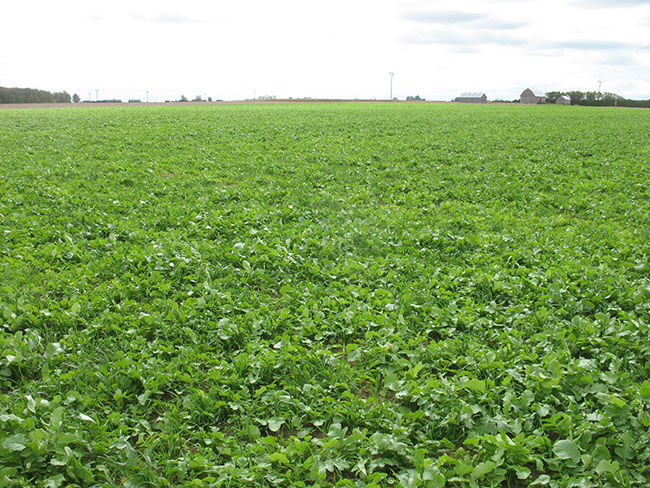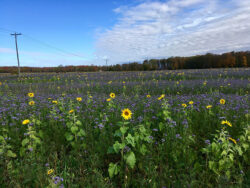
Features
Cover Crops
Cover crops a powerhouse tool for building carbon
New research examines the benefits of – and barriers to – long-term cover crop adoption.
November 28, 2023 By Julienne Isaacs
 Cover crops planted in commercial fields in Ontario.
Cover crops planted in commercial fields in Ontario. Laura Van Eerd might be one of the busiest cover crop researchers in Canada – if not all of North America.
A professor of sustainable soil management at the University of Guelph, Ridgetown Campus, Van Eerd’s work focuses on nitrogen and carbon cycling in agroecosystems. Two recent publications on cover crops look at different aspects of how cover crops can be used to boost agroecosystem services, such as storing carbon, while also improving farm economics – for example, via yield boosts.
Sustainability, for Van Eerd, has to do with both the environment and the farm gate.
One study, a long-term cover crop experiment comparing four different cover crop types to a no-cover crop control that began back in 2007, looks at cover crops grown in a processing vegetable system and in a grain production system. The goal of the study is to assess the ability of the different cover crop treatments to store carbon – and to provide economic returns.
The study is divided into two sites; the study at site A began in 2007, with another site added in 2008.
“We have five treatments – a no-cover crop control, which we keep weed-free in the fall, and then we have oats, rye, radish and a mixture of rye-radish. The rye we’re using is a winter cereal rye,” Van Eerd says.
“If we think back 15 or so years, it was pretty novel to [grow] two cover crops at the same time. Now it’s less so.”
The grain crops used in the study are corn, soy and winter wheat.
Analysis of data collected from the first nine years of the study at each site found that the total amount of plant carbon added to the soil via cover crops did translate into greater soil organic carbon content, Van Eerd and her co-authors write. In vegetable crops, greater yields and reduced yield variability did suggest the long-term potential of cover crops in boosting agroecosystem resilience.
However, in grain crops, the authors found that profit margins were likely to decrease with the use of cover crops – a finding partially explained by the inclusion of wheat in the study when wheat prices were low, and by the necessity of using a herbicide to terminate cereal rye before planting.
What this means, the authors conclude, is that more research is needed to identify the cover crops that are most likely to boost profits in grain systems – and that a carbon-capture compensation program could provide incentive for adoption of cover crops.
Putting research to work on the farm
Another of Van Eerd’s recent publications on cover crops uses a different zoom scale.
It’s a review of the impact of cover crops on the Earth’s biosphere, lithosphere, hydrosphere, and atmosphere across North America, and explores barriers to the adoption of cover crops in agroecosystems.
Cover crop termination techniques, added cost from cover crop integration, uncertainty around economic returns with cover crops and designing crop rotations to fit cover crops were some of the major barriers limiting the adoption of cover crops in production systems, they write. But cover crops offered a wealth of benefits.

Mixed cover crop.
Photo courtesy of Gerard Cornelis Farms.
“Overall, the review results suggest that cover crops increased subsequent crop yield, increased soil organic carbon storage, increased weed suppression, mitigated N2O emissions, reduced wind and water erosion, suppressed plant pathogens, and increased soil microbial activity and wildlife biodiversity,” the authors conclude. “However, the magnitude of benefits observed with cover crops varied with cover crop type, location, and the duration of cover cropping.”
It’s a lot to parse. But what Van Eerd thinks farmers can learn from this research is that the interactions between crops and cover crops is extremely complex.
“Cover crops are promoted for many different beneficial things. Right now, we think of cover crops as this one thing, but it’s not just one thing,” she says. “There are lots of different types of cover crops. There is a list of 30 different cover crops that will work very well in Eastern Canada. Each species has a different function or thing that they’re good at.”
For example, some cover crops grow very quickly and cover the soil quickly; these quick-growing species can help boost yields. Other cover crops suppress pathogens. The challenge, says Van Eerd, is in identifying which cover crops can be grown after you harvest your crop and still have time to do what you want them to do.
It sounds overwhelming, but there are many tools to help with decision making. One such tool is the Cover Crop Decision Tool, hosted online by the Northeast Cover Crops Council. Producers can select cover crops based on their desired effects. The tool was built using local data and information sourced from researchers, extension workers and growers.
Van Eerd is currently conducting research with scientists in New Liskeard looking at cover crop biodiversity, asking whether it matters whether you’re planting one or many species of cover crops together, and evaluating the efficacy of using cover crop biostrips in corn.
Another study, conducted at the long-term cover crop site, will look at the yield response of corn to multiple years of cover crops or one year of cover crops versus no cover crops.
“The work is ongoing, [but] we are seeing some difference in terms of corn response, where the corn is yielding higher with the long-term [cover crops] than the no-cover crop, [with] the one year of cover crop use in between,” she says.
As Van Eerd and her collaborators continue to gather data, their results and recommendations will become more nuanced commensurate with the complexity of the experiments. But one thing is very clear.
“Plant any cover crop and you will see benefits,” she says. “Choose the one that fits best with your other needs.”